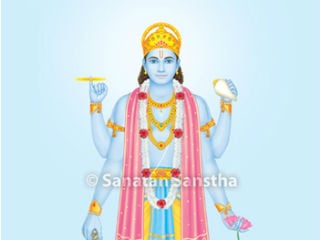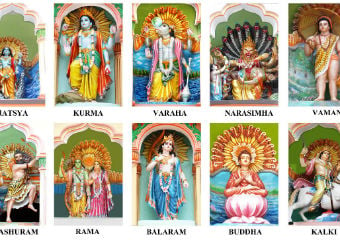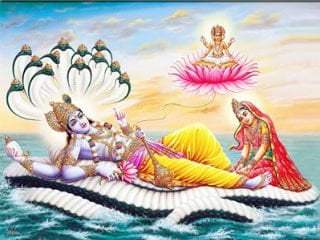Contents [hide]
- 1. The Deity of nourishment
- 2. One who is kind and gracious to His devotees
- 3. One who always keeps His promises
- 4. One who maintains the balance of the world
- 5. The steady Deity
- 6. The foremost Guru
- 7. One who converts solid and liquid form medicine into Vayu-form medicines
- 8. Physical features
- 9. Principle, capability and manifest Shakti
God created the universe through the five Deities (Principles)- Prajapati, Brahma, Shiva, Shri Vishnu and Meenakshi. These five Deities have all the characteristics of God besides their own. Sheshashayi, Anantashayani form of Shri Vishnu that theVaishnavsect worship, meaning, the nirgun (Unmanifest) form of Shri Vishnu is a representation of Supreme God or Mahavishnu.To them, Shri Vishnu, who loves His devotees, is God and the one with Shri Lakshmi is Maya (The Great Illusion). (To the followers of the Shaiva sect,Shiva in the nirbija superconscious state is His nirgun form or Supreme God. Shiva in meditative state is God and the one in dancing pose or the one playing a game of dice with Parvati is Maya.) ‘Maha’ means formlessness or the entire universe. Yet,when the word ‘Maha’ is prefixed to the words Shiva, Vishnu, etc. it does have the Principle of Shiva, Vishnu, etc. in subtle most form.The characteristics correspond to the respective forms.Other characteristics of Shri Vishnu are given ahead.
1. The Deity of nourishment
Annarasadevata :Anna – ad – that which feeds on living beings and that which living beings feed on, is known as anna(Food). Quotes like ‘ओषधंअन्नम्।’, ‘ओषधेचिन्तयेत्विष्णुम्।’ are prevalent in Sanskrut. The meaning of these quotes is – ‘Food generates radiance in the body.’ In the stotra ShriVishnusahasranam,Vaidya (Doctor) is one of the Names of Shri Vishnu.
2. One who is kind and gracious to His devotees
The authors of Puranas have glorified Shri Vishnu’sbhaktavatsalya (Kind to worshippers) for His devotees. It was He who rushed to the rescue of the elephant King Gajendra during a crisis and led him to salvation. It is He who assumed the Mohini form and acquired the amrut (Nectar) for the Deities during the battle between the Deities and demons. It was He who placed Dhruva in the infallible position. It was none, but He who manifested from a pillar as Nrusimha for the sake of His devotee Prahlad.Sage Durvas had cursed Shri Vishnu’s devotee Ambarish that he would be born ten times. For the sake of His disciple’s welfare, He took this curse upon Himself. He took upon Himself the burden of spiritual and worldly problems of His devotees.
3. One who always keeps His promises
- नमेभक्तःप्रणश्यति। – Shrimadbhagwadgeeta, Adhyaya 9, Shloka 31Meaning : My devotee never perishes.
- यदायदाहिधर्मस्यग्लानिर्भवतिभारत।
अभ्युत्थानमधर्मस्यतदात्मानंसृजाम्यहम्।।- Shrimadbhagwadgeeta, Adhyaya 4, Shloka 7Meaning : Whenever there is deterioration in Dharma(Righteousness), that is, when there is an upsurge of unrighteousness, Incarnate.
4. One who maintains the balance of the world
In Kaliyug(Era of strife), man’s temperament is more Tama-predominant. Hence, to maintain the balance of the world it is necessary to increase the Sattva component. The task of increasing devotion of the devotees and destroying the evil in society for reducing the Tama component is accomplished by Shri Vishnu.
परित्राणायसाधूनांविनाशायचदुष्कृताम्।
धर्मसंस्थापनार्थायसंभवामियुगेयुगे।। – Shrimadbhagwadgeeta, Adhyaya 4, Shloka 7
Meaning : To deliver the pious and to annihilate the evildoers aswell as to reinstate Dharma, I incarnate, era after era.
5. The steady Deity
Shri Vishnu functions without leaving His seat because He exists in water, on land, in wood, stone, etc., in other words, wherever there are particles of annarasa.
6. The foremost Guru
It was Shri Vishnu who started the Guru-disciple tradition. Narayan is the first Guru and Narad, the son of Brahmadev, is the first disciple. Since the very mission of aGuru is to take His disciple to Moksha (Final Liberation), it is said- ‘ज्ञानम्इच्छेत्सदाशिवात्मोक्षम्इच्छेत्जनार्दनात्।’ – We must seek knowledge from Sadashiva and Moksha from Janardan, that is,from Shri Vishnu (According to the Shaiva sect the Guru-discipletradition began with Shiva, His first disciple being Shri Vishnu or Parvati.)
7. One who converts solid and liquid form medicine into Vayu-form medicines
The Holy text ‘Bruhad-Nighantu-Ratnakar’gives information on Ayurveda, the science of medicines. Following five types of medicines have been mentioned in it.
1. Medicines from grass,
2. Medicines found in the forest,
3. Medicines from living organisms (for example milk, musk),
4. Medicines found in water and
5. Medicines found in the earth.
Shri Vishnu converts all medicines in all these forms into Vayu (Absolute Air Principle)-form medicines. Consequently solid and liquid form medicines are quickly absorbed into the blood and therefore, into the body cells. Vayu-form medicines are absorbed into the body by mere inhalation.
8. Physical features
A. Complexion
Shri Vishnu has a blue complexion. The bluedot seen during meditation and that of the subtle most Divine bluewater is that of Shri Vishnu’s blue complexion.
B. Shrivatsalanchhan
There is a white hairy spiral on His heart, which is called Shrivatsalanchhan. In this context, the story in the Puranas is – Once, on the banks of River Saraswati, Sages held a discussion on who among Brahma, Vishnu and Mahesh is superior. It was unanimously decided that Bhrugu maharshi, who was treated as a son by Brahmadev, should give the decision.Bhrugu maharshi first went to Brahmadev and stood in front of Him without paying Him obeisance. Brahmadev was furious at the insult by His own son; however, He pardoned Bhrugu maharshi since he was His son. Then Bhrugu maharshi went to Kailash to meet Bhagawan Shankar (Shiva). Bhagawan Shankar came forward to hug Bhrugu maharshi; but he refused to be hugged. This infuriated Bhagawan Shankar and holding His Trishul (Trident),He ran after Bhrugu maharshi to kill him. In the end Parvati calmed His anger. Thereafter, Bhrugu maharshi went to Vaikuntha(Shri Vishnu’s region) to meet Shri Vishnu. Shri Vishnu was having a nap at that time.Bhrugu maharshi kicked Shri Vishnu on heart (chest). Shri Vishnu immediately woke up, placed his head on the feet of Bhrugu maharshi and said, “Pardon me ! Since I did not know about your arrival, I could not welcome you. While kicking my hard heart(chest), your delicate feet must have got hurt !” Saying this, Shri Vishnu began to massage the feet of Bhrugu maharshi. He added,“Today you have blessed me a great deal. The dust from your feet will now always remain on my heart (chest).” Thereafter, Bhrugu maharshi returned to the gathering of the Sages and gave his decision that Shri Vishnu is the superior most.
C. Garment draped around the waist
It is called a pitambarand is yellow.
9. Principle, capability and manifest Shakti
A. Principle
100 % (God = 100 %)
B. Capability
Fundamental mission is threefold – Creation,Sustenance and Dissolution. Of the total capability of Shri Vishnu,2% is used for Creation, 96% for Sustenance & 2% for Dissolution.
C. Manifest energy
Just like God, Shri Vishnu too utilizes only 10% of His Shakti (Divine Energy) to carry out His mission. This Shakti being used is known as manifest energy. The Shakti that is not used is known as unmanifest energy. Depending on the mission, if moreShakti is required, then the proportion of manifest Shakti is more.

 Forms and Family of Shri Vishnu
Forms and Family of Shri Vishnu The ten Incarnations of Shri Vishnu
The ten Incarnations of Shri Vishnu Science of the idol of Shri Vishnu
Science of the idol of Shri Vishnu Vaikunth chaturdashi is an invaluable opportunity granted to us to worship Deity Shri Vishnu
Vaikunth chaturdashi is an invaluable opportunity granted to us to worship Deity Shri Vishnu Why a specific Name of Shri Vishnu is used for a specific task ?
Why a specific Name of Shri Vishnu is used for a specific task ?